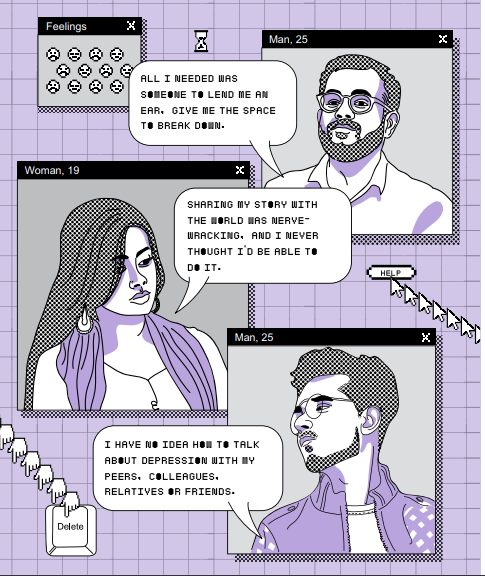Young Indians Speak About Mental Health
exploring youth mental health
I hope that reading my story might help others feel less alone. It is important to know that other people are fighting the same battles. This is for anyone who feels stuck, overwhelmed or hopeless. You are not alone. (Woman, 24, www.itsoktotalk.in)
We spend a great deal of time and resources on the research, design and implementation of various mental health interventions, often without acknowledging the central role of users’ experiences in shaping the efficacy of these interventions. I am not sure if I realized, when I began my work with ‘It’s Ok To Talk’, a young people’s mental health project in India, just how powerful and central people’s stories could be. India has the world’s largest population of young people in the 10-24 age group, and mental health problems are a major health concern in this period. In fact, suicide is a leading cause of death for young Indians. And yet, fewer than 10% of young Indians have access to formal mental health services, highlighting an urgent need for innovative strategies to promote mental health for this age group nationally. The negative impacts of youth mental health problems are starkly reflected in the strong association between poor adolescent mental health and long-term social disability.
There is now a growing interest in the use of social media platforms for mental health promotion and stigma reduction, particularly among young people. The’ ‘It’s Ok To Talk’ website, inspired by “Depression: Let’s Talk” – the WHO theme for World Mental Health Day, 2017 – invites young people to share their personal experiences of mental health needs, resilience, and recovery, in any media form of their choice.
social media as safe space
We recently carried out a qualitative research study based on submissions to this website from 33 young authors. A group of eight of the authors came in as collaborators, offering us feedback and suggestions on our coding framework and on the paraphrasing of selected quotes, and reviewing our final manuscript. Four overarching themes were identified through the narratives: living through difficulties; mental health in context; managing one’s mental health; breaking stigma, and sharing hope. Almost all submissions contained personal experiences of distress, with the embodied experience of mental health difficulties as being physically and mentally overwhelming. Loneliness, isolation, and a strong desire for connection were manifest, mirroring findings from other qualitative studies of youth narratives in highincome countries. The scope for articulating and sharing these painful experiences appeared to be an important function of the website.
Though public discourse on social media use often emphasizes their negative impacts, more recent research suggests that the effects may depend on the way these platforms are used. Individuals with stigmatized illnesses often avoid seeking healthcare. In such situations, reading or hearing about the experiences of others can help build awareness, challenge stigma and encourage healthrelated decision-making. Young people with mental health difficulties report that one of their primary reasons for connecting with others online is to feel less alone. We found young persons were more inclined to seek mental health care if they felt able to express their feelings, and have information about mental health issues as well as available sources of support.
social media referencing the psychosocial
Several authors described their mental health difficulties with reference to their socioeconomic and cultural contexts. The submissions thus went beyond accounts of internal experiences alone, to explore and challenge the societal and political contexts of psychological distress, and offer a rich, multi-dimensional understanding of mental health. Narratives highlighted how rigid social norms often contribute to poor mental health by forcing oppressive and unrealistic expectations on young people, which exacerbate stress. In India, stress related to academic performance, and resulting from failure in exams, has been noted as a predictor of suicidal ideation. This is consistent with research in other low-income and middleincome countries, which has found academic, interpersonal and family difficulties to be among the key social determinants of poor mental health and suicide in young people.
Anxiety and depression felt like parts of me that would take over at different times. Seeing yourself as mentally unwell makes you feel helpless about how to handle it. (Man, 23)
I feel caged from within. It’s exhausting to keep up with the struggle. I am afraid I might be losing the battle. A part of me is dying everyday. (Man, 25)
The influence of stigma was prominent in narratives around recovery; whereas an acceptance of mental health problems appeared to play a central role in many authors’ journeys of recovery. Some authors expressed a personal motivation to mitigate public stigma, reduce self-stigma, and help others:
We must talk about mental health at every level – in schools, at work, with medical professionals and in the media. We need more nformation and awareness so that people can spot problems and get help. It’s not just ok to talk, it is absolutely essential! (Woman, 29)
Being responsive to young people’s views, and ensuring their voices are part of building strategies, is absolutely critical to addressing the care gap and meeting their needs. Such personal narratives provide a window into young people’s priorities, as well help highlight specific themes for future awareness-building and service design efforts. These stories, and the key messages contained in them, are invaluable both for promoting the mental health and well-being of young persons, and informing us of attitudes regarding mental health needs in the wider community. ¤
“We spend a great deal of time and resources on the research, design and implementation of various mental health interventions, often without acknowledging the central role of users’ experiences in shaping the efficacy of these interventions”
